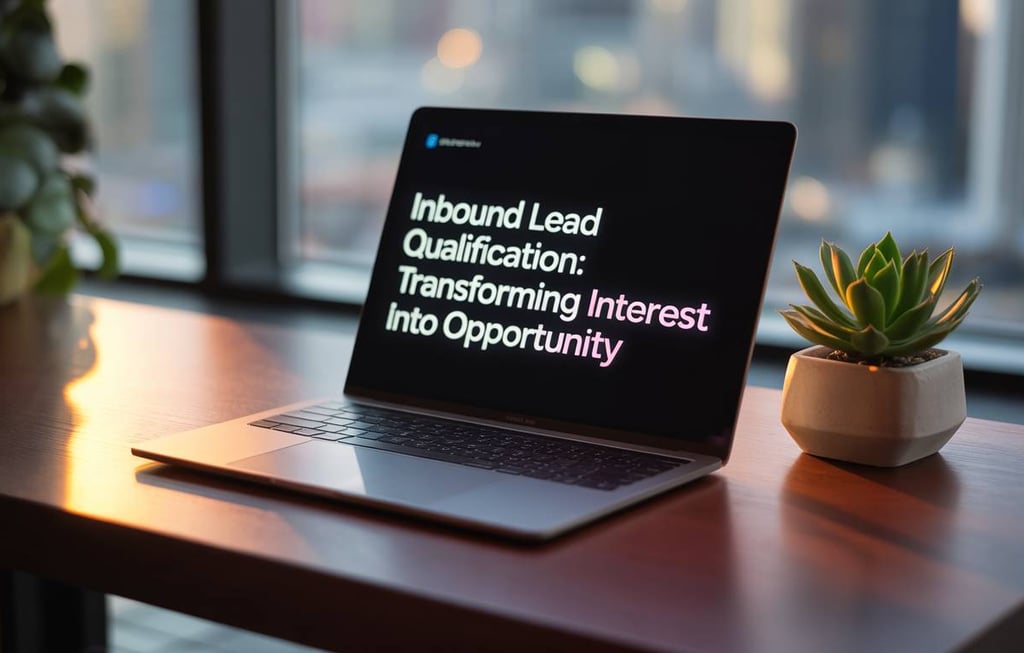Inbound Lead Qualification: Transforming Interest Into Opportunity
Learn how inbound lead qualification strategies and tools help businesses identify high-quality leads, improve sales performance, and maximize marketing ROI.
Lilo
7/29/20257 min read



As potential customers engage with businesses on the internet, inbound leads have now become an essential driver of revenue growth. It is important to note that not every prospective buyer who engages with your content is a warm lead.
Filling out a form, downloading material, and subscribing to newsletters does not make one a qualified lead. This makes inbound lead qualification a crucial component of every streamlined sales process.
Evaluating criteria such as quality, intention, and fit to ascertain the incoming leads’ quality is referred to as the inbound lead qualification process. It allows to ensure marketing and sales teams to operate separately and efficiently.
As long as marketing gets useful feedback, it will continue to effectively target the intended audiences. Once executed correctly, inbound lead qualification helps overcome the divide between investment and curiosity.
This piece discusses the philosophies, tactics, and technologies of effective inbound lead qualification as well as their impact on companies’ revenue operations optimization.
Understanding Inbound Lead Qualification
Inbound lead qualification will involve assessing leads that come to a business through either paid or organic marketing channels. These leads initiate contact via forms on the website, content downloads, event registrations, or interaction with a Chatbot. Inbound leads are always warmer than cold prospects because they have expressed some sort of interest, but the actual willingness to buy may differ greatly from person to person.
The main objective of the qualification is to determine if there exists a lead that justifies an outreach from the sales team. Some of these criteria include budget, whether the person is an employee with decision-making authority, the need for the business, timeline, and how well the lead aligns with the company’s ideal customer profile.
Such leads will be classified as sales qualified leads (SQLs) while other leads who do not meet these criteria will be marked for longer-term nurturing.
Effective inbound lead qualification helps prevent responding to anyone who expresses interest, instead ensuring that time and resources are preserved for prospects with actual and genuine potential.
Why Qualifying Inbound Leads is Essential
Inbound leads can convert at a higher rate than cold leads, but assuming they’re ready to convert is a mistake. Some may just be gathering information. Others don’t have the necessary budget or organizational power to move forward in the process.
Without qualifying, assuming every inbound lead is ready to convert is risky, as that would in fact flood your sales team with a backlog of unqualified leads.
Qualifying inbound leads efficiently improves sales productivity. It allows sales representatives to better manage their outreach and conversations to those that are likely to result in revenue, and also improves the customer experience as buyers receive communication that aligns with their level of preparedness to buy.
Lead qualification also assists in improving feedback for the marketing team. By identifying which marketing campaigns are successful in generating qualified leads, the messaging, content strategy, and channel spend can be adjusted. Over time, this creates a feedback loop that improves marketing and sales effectiveness.
The Most Essential Factors for Qualification
Although every company has its own policies regarding criteria for inbound lead qualification, certain elements are widely acknowledged as the foundations, including demographic and firmographic fit, engagement behavior, authority to buy, business need, and purchase timeline.
Analyzing a lead's demographic and firmographic data helps customize marketing strategies to suit specific customers. For B2SB businesses, this may include industry, company size, job title, or geographic location. For B2C businesses, age, income level, and lifestyle indicators tend to be more relevant.
Engagement associated with a lead helps determine their interest levels. The individual who downloads multiple whitepapers, spends time on high-intent pages, or frequently revisits the site is likely more serious than someone who signed up for a newsletter and disappeared.
Authority and budget are typically captured through form fields or follow-up interactions. Purchaser-empowered leads are prioritized over those who lack the ability to make or influence a buying decision. A clear business need is equally critical because leads with relevant pain points are more likely to advance through the sales funnel.
Lastly, the purchase timeline helps determine cadence and methods of outreach. A lead with an immediate project requirement is more valuable than one who is considering options a year from now. That said, if segmented properly and nurtured, both could be valuable.
Manual vs. Automated Qualification
Inbound lead qualification can be accomplished as a hands-on process either via outreach and direct assessment or through the use of software tools. A number of companies seem to favor a balanced model, where the initial stages are automated and human judgment is applied at more critical stages.
Engagement and qualification revolve around sales development representatives (SDRs) assessing a prospect's information, conducting a discovery call, and probing through tailored questions that reveal a lot.
That person-to-person interaction provides a wealth of insight, as well as the ability to personalize a solution based on need that comes with great value and is often indispensable in the context of expensive goods or intricate business-to-business sales processes.
In contrast, automation implements a more controlled way of doing things to expand the scope of qualification that a business can handle. Automated marketing systems can evaluate leads using behavioral and demographic information, automatically assigning those who satisfy specific requirements to sales.
Also, qualifying leads in real time through the asking of pre-planned questions and custom responses is a feature of chatbots and conversational AI.
Formulating a Scoring Model for Inbound Leads
A lead scoring model systematically evaluates each incoming lead to determine its value based on specific attributes and actions. It assists in deciding which inbound leads to focus on and which ones need nurturing or are bad fits.
Scoring models allocate points to actions such as visiting pricing pages, making demo requests, and spending time on the site. Points can also be assigned based on form responses, such as company size and title. On the other hand, generic email addresses, low engagement, or non-target industries could result in zero or negative points.
Regular updates to scoring models ensure accurate and relevant results. Providing feedback on which attributes accurately predict sales conversions grants teams the ability to adjust weightings, remove ineffective signals, and add new signals as necessary.
The use of static scoring systems helps align marketing and sales. An agile approach aids the teams in maintaining a correct view of the quality of the pipeline.
The Function of Conversational AI
Conversational AI has become a critical tool in inbound lead qualification. Chatbots driven by AI technology can directly engage with leads on company websites, query them at different qualification levels, dispense information, or even schedule demos, without requiring human input at any stage.
This engagement captures interest at the peak and eliminates latency. Businesses are also able to collect qualification data without leads being required to submit long forms. Some sophisticated bots can check a lead against certain predefined critical factors and qualify them to a specific sales team or a nurturing sequence automatically.
Some of these bots are designed to work during human representatives’ overtime blocks or on weekends as augmentative aides. When these bots are connected to the CRM and marketing platforms, they become part of the lead scoring and segmentation processes, improving these two parameters immensely.
Defining a scoring model together, setting unambiguous transfer protocols, and analyzing conversion metrics fosters collaboration and knowledge sharing between the two departments. It is critical for marketing to know how engaged the handed-off leads are and for sales to share insights about the lead's quality and the outcomes post-conversion.
Technological Resources and Tools for Inbound Qualification
The proper inbound lead qualification depends highly on an organized stack of marketing and sales technologies. Many organizations utilize CRM systems alongside marketing automation tools, predictive intelligence software, conversational AI, and analytic applications.
Salesforce or HubSpot offer CRMs that gather and store lead data while keeping track of various interactions throughout the customer journey, servicing different departments. For lead scoring, nurturing workflows, and advanced segmentation, one may utilize marketing automation platforms such as Marketo and Pardot.
Real-time engagement and qualification can be done through tools like Drift and Qualified, which focus on conversational AI. Ensuring these systems are integrated enhances the overall inbound qualification processes.
Marketers can now trust that there is smooth data transfer, unified visibility across the silos, and actions are triggered based on the lead's actions. This unified system approach leads to fast response times, better lead handling, and agile improvements that are grounded in steady refinement.
Inbound Qualification Errors
Inbound lead qualification remains an area of challenge for many, and some companies seem to make the same mistakes often. One prominent area pertains to form fields that serve as a primary qualifier inside the inbound qualification processes.
While capturing data through forms is helpful, they are often inaccurate. Filling the gaps through behavioral data, enrichment tools, or conversational AI provides a much more accurate picture.
Another oversight is waiting too long to act. Inbound leads are generally sensitive to time. Even a few hours can result in lost opportunities due to competition. Systems used for qualification should be capable of automated follow-ups and rapid response engagements.
Another oversight that can prove costly is failing to properly define scoring models. Attempting to score numerous parameters can result in team confusion and a loss of the system’s intended purpose. It’s best to implement a straightforward model first and improve it iteratively based on real-world results.
Lastly, businesses tend to aggressively disqualify leads, too, sifting out prospects that could convert with some nurturing. Qualifications should help define the next steps, but should never close the door permanently.
Conclusion
Inbound lead qualification is more than filtering, it shapes interest into opportunities that can be strategically acted upon. In an era where sales cycles differ and customer journeys are complex, qualifications that factor both behavior and fit help ensure businesses channel resources to the most critical prospects.
Companies can enhance efficiency while improving conversion rates and customer relations by nurturing inbound leads with intelligent scoring models, real-time engagement tools, and alignment across cross-functional teams. Inbound leads are indeed valuable, but only when they can be intelligently nurtured and expertly guided through a scalable qualification framework.
Companies that are proficient in inbound lead qualification streamline scope for control, clarity, and a competitive advantage in the ever-shifting landscape dominated by buyers. They also gain more than just pace in the pipeline.




Contact us
Whether you have a request, a query, or want to work with us, use the form below to get in touch with our team.


Location
3721 Single Street
Quincy, MA 02169
Hours
I-V 9:00-18:00
VI - VII Closed
Contacts
javier@smarterpath.ai
mariano@smarterpath.ai
+1 (917) 684-3554
Copyright © 2025 SmarterPath. All rights reserved.
